First Drive: The Lamborghini Revuelto Hybrid Has Come a Long Way From the Prius
Unmistakable screams, wails, and burbles of V12 engines resonate through the hills around Autodromo de Vallelunga, just north of Rome. The soundtrack could just as easily be from 60 years ago, as Lamborghini tested a new V12 engine for it's first production car, the 350GT. Instead, it’s 2023 and Lambo has invited select media to experience the new Revuelto hypercar, the iconic Italian automaker’s most powerful car ever—that also just happens to be a hybrid.
Everyone crying over, or even on the fence about, Lamborghini’s inevitable pivot to electric power needs to take a breath and watch a few Instagram reels capturing the latest V12 at full throat. Yes, massive internal combustion engines may well go extinct in the near future but Lambo purposefully developed the Revuelto’s hybrid system while clinging furiously to the past. We’ve come a long way from your grandma’s Prius, and not just because of the $600,000-plus price tag.
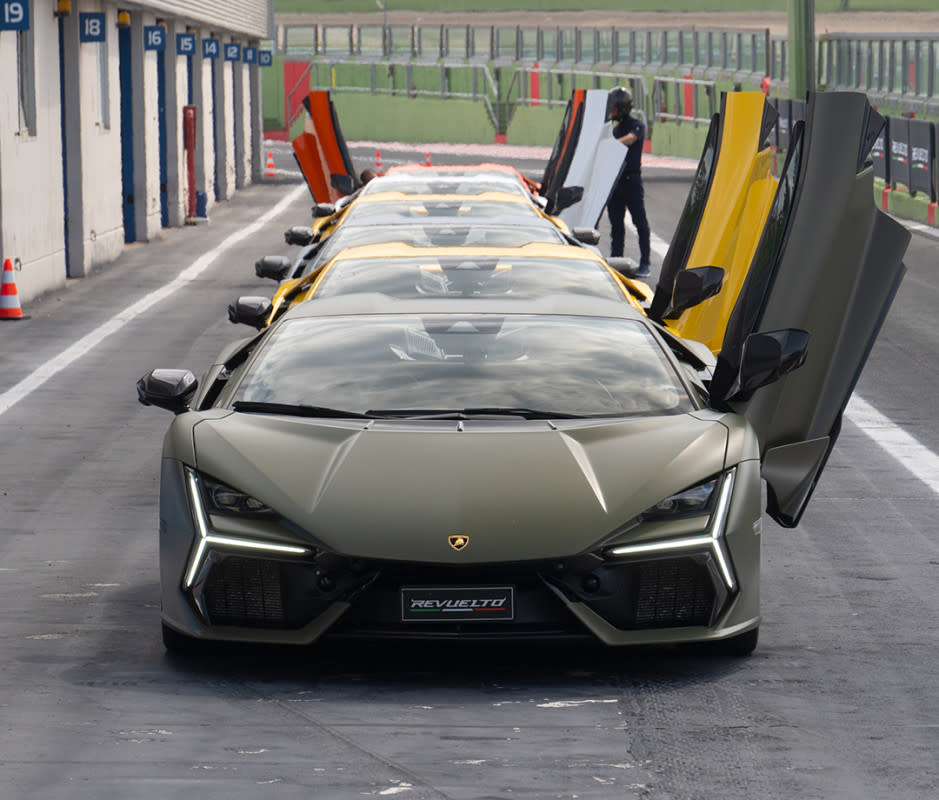
Michael Teo Van Runkle
Engaging Emotions With a Plug-In Hybrid
Before the Revuelto’s official debut earlier this year, Lamborghini set the stage by insisting to anyone who would listen that the electric revolution will allow for enhancement of performance, rather than strictly satisfying carbon emission regulations. The Revuelto’s stats on paper prove the point with purpose, as three electric motors contribute to a combined output of 1,000 horsepower. The trio of e-motors alone produce almost as much total torque as the 6.5-liter V12, bolstering bottom-end boost to allow for a 0-60 time of only 2.5 seconds—no joke, placing the Revuelto solidly in hypercar status (and not just because of that price tag).
But full EVs have lately rendered straight line acceleration numbers largely irrelevant. So how can the Revuelto driving experience coalesce into the quintessential emotionality that Italian automakers obsess over? Well, therein lies the challenge that Lamborghini faced while developing this new hybrid, a process that relied on capturing the old magic then unleashing it in new form.
Related: First Drive: The Lotus Emira Is a Stunning Mini Supercar
Bolting on three electric motors means the naturally aspirated V12 can prioritize delivery of its own 813 horsepower higher in the rev range thanks to more aggressive camshaft profiles and an exhaust system that doesn’t need to perform the dual function of reining in emissions at the lower end while choking higher RPMs.
The two front axial flux e-motors peak at 258 lb-ft of torque each, while the third, a radial flux unit mounted atop the transverse eight-speed dual-clutch gearbox at the tail end of the drivetrain, puts out 110 lb-ft. So not only does the V12 itself improve in both efficiency and emissions, but the whole combo can satisfy increasingly stringent government regulations while also putting down enough shove at any RPM to satisfy journalists spoiled rotten by instantaneously available electric torque.
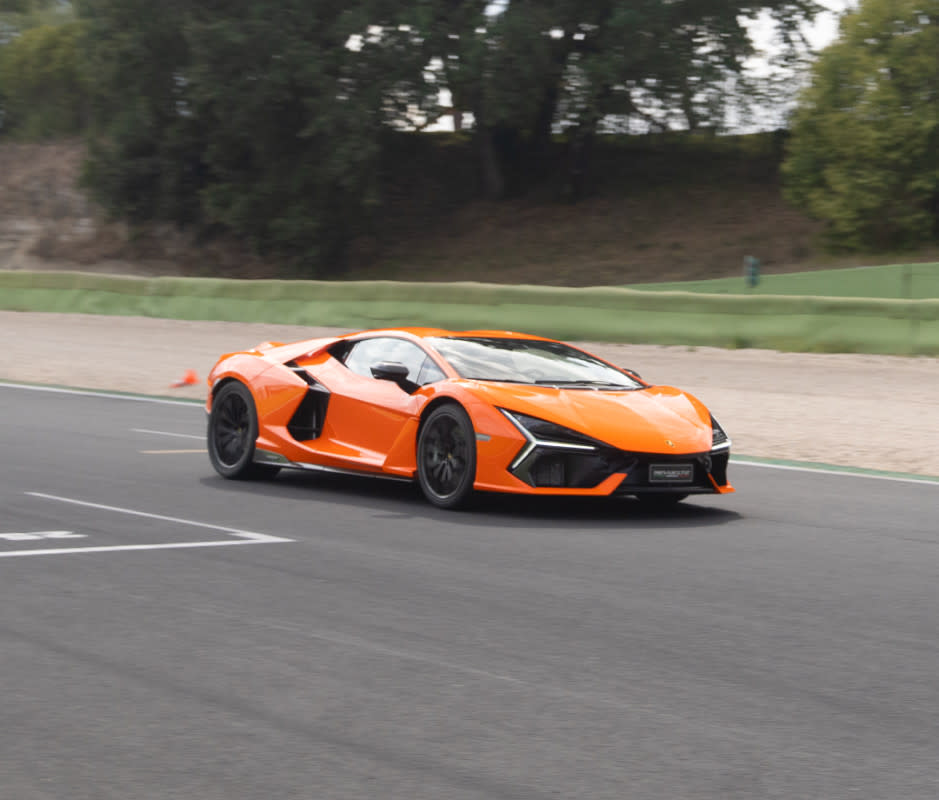
Michael Teo Van Runkle
Coaching the Uncoachable
At Vallelunga, Italian lead-follow driver Nicoló Piancastelli often radios in telling me to pop the paddle shifter into a gear higher than I might have thought perfect for each corners. He’s tested the Revuelto extensively, so he trusts that wide torque curve even as I mostly ignore his coaching and prefer instead to wind right up towards the V12’s 9,500-RPM redline. And the eight-speed DCT, mounted transversely behind the V12 on a road-going Lambo for the first time since the Miura, marks quite possibly the biggest advancement for Lambo’s new flagship—most importantly, leaving the Aventador’s lamentable seven-speed automated manual entirely in the dust.
The e-motor mounts above that DCT, capable of powering the back two wheels via a secondary input shaft. Lambo fitted the rest of the electric components as perhaps expected, with batteries mounted longitudinally in what we might have called a “transmission tunnel” in the past. The two front motors, one for each wheel but essentially mounted as a single unit, never physically connect to the rear ICE and electric combo—so the Revuelto runs mostly in front-wheel drive while in full electric mode, but can feed a bit of AWD in through that secondary shaft when required.
We’re solidly into the realm of computer programming here, the exact kind of bits and bytes that haters worry will absolutely ruin the engaging spirit of the V12 engine and Lamborghini as a brand. On the Corvette E-Ray, with only one fully separate electric motor (and much more attainable for keyboard warriors), such concerns might prove valid. But the Revuelto’s two front and third rear motors, as well as that refined torque vectoring, creates an entirely different persona, even if the real-world performance of the system functions almost 100 percent counter to expectations.
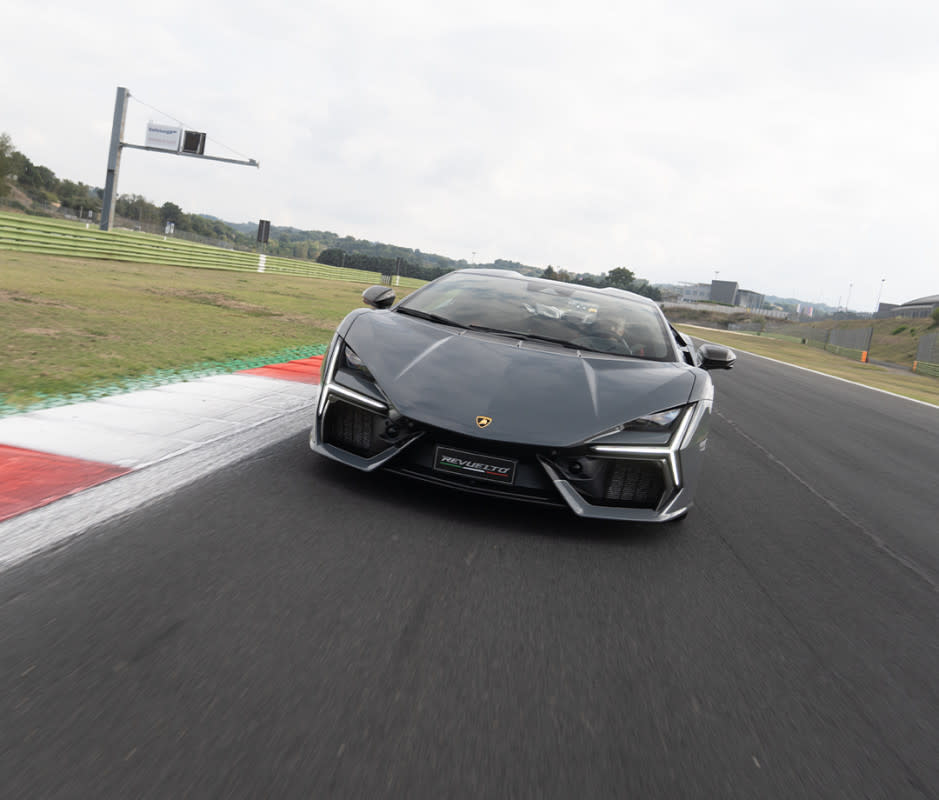
Michael Teo Van Runkle
Begging for More at Vallelunga
Hustling at high speeds down the track banging through third to fourth and then fifth gear, the front motors contribute minimally to power or traction. But at first tap of the brake pedal, regen feathers in as the caliper pistons begin to blend bite up to 0.3 g of deceleration. Once the tail stops shimmying—despite the hybrid powertrain, the Revuelto still overbalances towards the rear with a 44:56 weight distribution—a bit of steering input prompts the front e-motors to prioritize traction via regen rather than adjusting braking balance, while also helping to recharge the batteries simultaneously.
The gob-stopping traction and light steering give me so much confidence in corners that a curb weight of 3,906 pounds can seem like a typo. And better rubber than the Bridgestone Potenza Sports fitted from the factory would probably ratchet the grip up to another level too. Meanwhile, exiting each turn, the front tires scrub a bit as the rears spin up into mild oversteer until the whole drivetrain suddenly syncs and that rally racing all-wheel drive helps the Revuelto squat and then push-pull out onto the straights once more.
Related: Heat Training Really Can Boost Endurance Performance, Study Finds
Just before the brake zone going into Vallelunga’s first turn, a gentle right hander on a slight downslope, I notice the Revuelto’s digital speedometer shuffling up to and maybe just beyond 280 kilometers per hour. That’s far too fast for public roads, and yet Lambo designed this hybrid hypercar to serve equally well as a daily driver, canyon carver, or track toy. Talk about a hard balance to manage, but even during a few track stints, the updated interior clearly prioritizes ergonomics on a level that matches only the Urus in Lamborghini’s past.
Compared to the Aventador, which is an absolute misery to actually sit in while driving, the Revuelto’s taller roofline and eight-centimeter longer wheelbase create much more interior volume in concert with a refined dash design. There’s even space behind the seats for a small bag or two.
In the current hypercar era, when 0-60 or even 0-100 times are equally as important as daily driveability, the Revuelto can now cater to luxury buyers as much as speed freaks. A Bugatti Chiron might occupy another level entirely but Lambo can rest confidently in the Revuelto’s comfort level amongst competition from most other options in the same class.
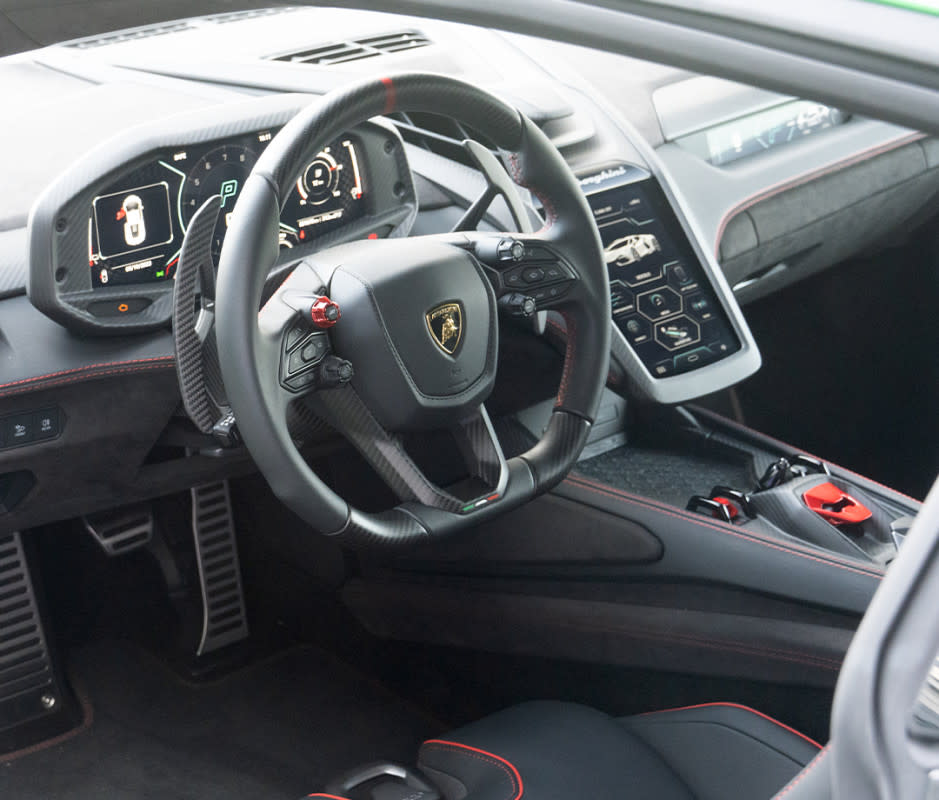
Michael Teo Van Runkle
Track Toy Turned Daily Driver
Somewhat surprisingly, Lambo claims to have consulted neither Bugatti nor Rimac during the Revuelto’s development, two siblings under the Volkswagen AG umbrella that might well have contributed knowledge, parts, or production expertise. Driving this first hybrid V12, in comparison to McLaren’s P1 and Porsche’s 918 Spyder that preceded it but used “only” twin-turbo V8 engines, I wonder how long such a massive naturally aspirated engine can hold out as the industry transitions to electrification.
From the cockpit, wearing a helmet and headphones that effectively blunt the engine’s raucous nature, the appeal wanes a bit. But standing in the pits as drivers rev up and the exhaust starts popping, burbling, and wailing off the echoic hills, all of a sudden that V12 magnetism rears up once more.
Lambo will not yet set a limit on how long the Revuelto’s life cycle will last, but if all the dedicated track toys that debuted at Monterey Car Week serve as any indicator, the electric future may well force enthusiastic one-percenters into more and more time on racing circuits rather than public roads. (Luckily, Lambo can lean on Ducati to help with fleet MPG averages.)
Related: 2023 Lamborghini Huracán Sterrato: Off-road Supercar
Despite a curb weight that ticks in 10 to 20 percent higher than other hybrid hypercars—while shredding tires during hard stints of only five or six laps—the Revuelto nails a fine line between approachability and intimidation. The fighter-jet interior switchgear and emphatic exterior aesthetic perhaps serve as some mild overcompensation to woo any hybrid holdouts. And that bright orange "Arancio Apodis" launch color doesn’t do the design justice in photos, highlighting C8 Corvette comparisons (especially from a side profile view) that entirely vaporize when up close and personal with the angular forms.
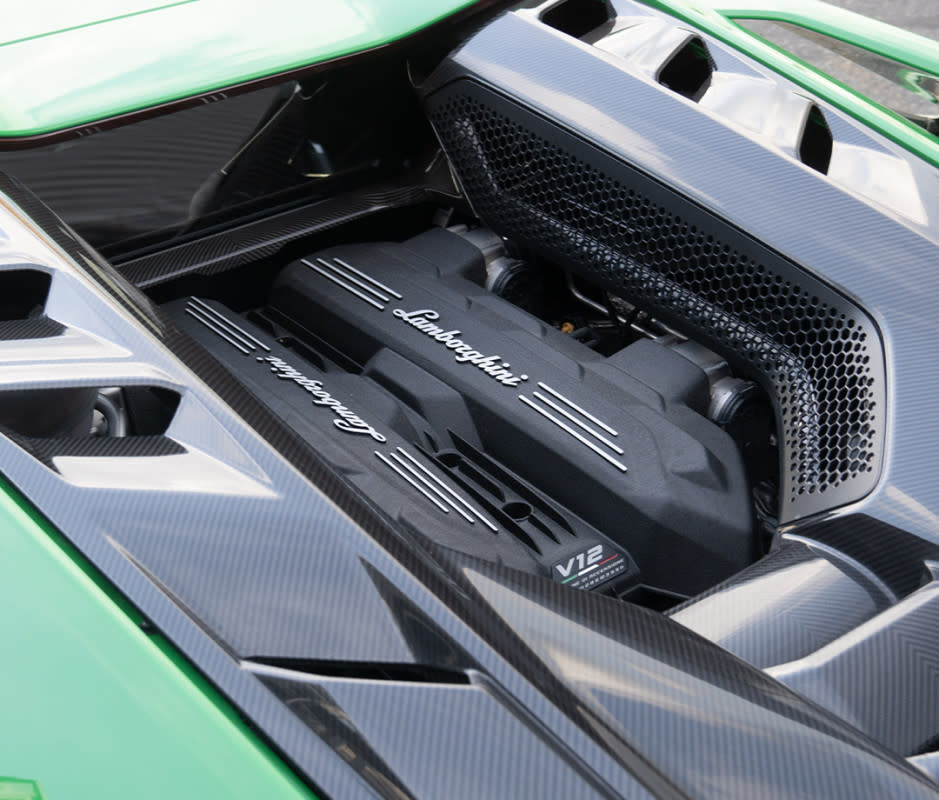
Michael Teo Van Runkle
At the pinnacle of automotive engineering and complexity, can a hybrid hypercar ever truly overcompensate for anything? From power stats on paper to lap times with amateurs behind the wheel, the Revuelto simply stands as proof of concept that a V12 can pair with electric motors to engage the senses while simultaneously delivering stupefying performance with ease. In this last gasp of internal combustion, Lamborghini clings to the past while stepping confidently into the future, an intimation of a new world order still resolving on the distant horizon.
Customers apparently believe in the prophecy too, if two years of already sold-out order books mean anything. The real question is why Lambo even invited the media to give it a go, rather than just unleashing the Revuelto on the world raw and ready to reinvigorate old rivalries with a supremely coherent, if somewhat unanticipated, modus operandi.
